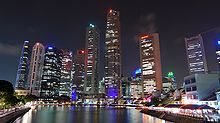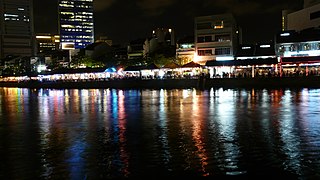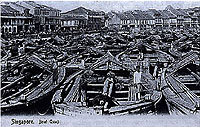
Geylang is a planning area and township located on the eastern fringe of the Central Region of Singapore, bordering Hougang and Toa Payoh in the north, Marine Parade in the south, Bedok in the east, and Kallang in the west.
Chinatown is a subzone and ethnic enclave located within the Outram district in the Central Area of Singapore. Featuring distinctly Chinese cultural elements, Chinatown has had a historically concentrated ethnic Chinese population.

Clarke Quay MRT station is an underground Mass Rapid Transit (MRT) station on the North East line (NEL) in Singapore. Situated along Eu Tong Sen Street, near the junction of Merchant Road and North Canal Road, it is at the south of the Singapore River underneath The Central. The station serves Clarke Quay and Boat Quay, as well as other landmarks such as Hong Lim Park, The Riverwalk and the Swissotel Merchant Court.

Tanjong Pagar is a historic district located within the Central Business District of Singapore, straddling the Outram Planning Area and the Downtown Core under the Urban Redevelopment Authority's urban planning zones. The district has a rich history and is known for its cultural and architectural landmarks, making it a popular tourist destination.
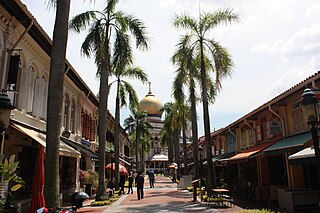
Kampong Glam is a neighbourhood and ethnic enclave in Singapore. It is located north of the Singapore River, in the planning area of Rochor, known as the Malay-Muslim quarter.

Clarke Quay is a historical riverside quay in Singapore, located within the Singapore River Planning Area. The quay is situated upstream from the mouth of the Singapore River and Boat Quay.

The Old Ministry of Labour Building is a former building of the Ministry of Labour located at Havelock Square in the Outram Planning Area, within the Central Area of Singapore's central business district. The building once housed the former Chinese Protectorate which was first established in 1877 to protect and control Chinese immigrants to Singapore. The building had since been restored in 1990 and currently used as the Family and Juvenile Court of Singapore.
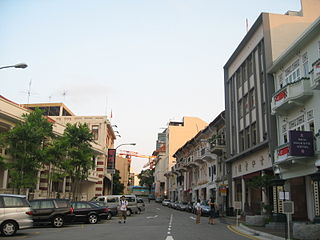
Bukit Pasoh Road is a road in Tanjong Pagar within the Outram Planning Area of Singapore. The road starts from Neil Road which is one way, but becomes two ways, when the road forks out into two parts, with one becoming Teo Hong Road, with both roads ending at New Bridge Road. The road is mainly lined with conserved shophouses and houses a high-end boutique hotel known as the New Majestic Hotel.

Keong Saik Road is a one-way road located in Chinatown within the Outram Planning Area in Singapore. The road links New Bridge Road to Neil Road, and is intersected by Kreta Ayer Road.

Tras Street is a street located in Tanjong Pagar in the Outram Planning Area and Downtown Core in Singapore. The road connects Enggor Street and Gopeng Street to Cook Street, and is intersected by Wallich Street.

Duxton Hill is a small hill, as well as the name of a road, located in Tanjong Pagar in the Downtown Core district of Singapore.

Gedung Kuning is a Malay historical residence in Singapore. Located at 73 Sultan Gate, Gedung Kuning stands just outside the Malay Heritage Centre, near Masjid Sultan in the historic district of Kampong Glam in Singapore. However, from 1919 to 1925, the Gedung Kuning's address was 33 Sultan Gate. Once forming an annexe to the adjacent palace of Singapore's Malay rulers, Istana Kampong Glam, it became the private residence of Haji Yusoff, a prominent Malayo-Javanese merchant and four generations of his family. Together with the Istana, the compound was refurbished as part of the development of the Malay Heritage Centre in 2004.

The Fullerton Hotel Singapore is a five-star luxury hotel located near the mouth of the Singapore River, in the Downtown Core of the Central Area, Singapore. It was originally known as the Fullerton Building, and also as the General Post Office Building. The address is 1 Fullerton Square. The Fullerton Building was named after Robert Fullerton, the first Governor of the Straits Settlements (1826–1829). Commissioned in 1924 as part of the British colony's centennial celebrations, the building was designed as an office building by Major P.H. Keys of Keys & Dowdeswell, a Shanghai firm of architects, which won the project through an architectural design competition. The architectural firm also designed the Capitol Theatre, its adjoined Capitol Building and the Singapore General Hospital. In 2015, it was designated as a national monument of Singapore.

Gallery Hotel was a four-star boutique hotel at Robertson Quay on Singapore River, in the Central Area of Singapore. Originally known as Gallery Evason Hotel, it was the first "HIP" hotel in Singapore, and the second in Asia, the first being in Japan.

Robertson Quay is a wharf near the source of the Singapore River. It is the largest and most upstream of the three wharfs on the river and is named after a municipal counsellor Dr J Murray Robertson. It now has al fresco dining as well as arts and culture.

Peranakan Place, formerly known as Peranakan Corner, is a row of six two-storey shophouses facing Orchard Road, built around 1902 at the intersection of Emerald Hill Road and Orchard Road in the planning area of Newton in Singapore. It forms part of the Emerald Hill Conservation Area within the Orchard district in central Singapore.
593 Serangoon Road is a shophouse on the corner of Serangoon Road and Balestier Road. It previously housed the Singapore Institute of Science and currently houses the Sin Peng Lounge.

Tong Ah Building is a building at the junction of Keong Saik Road and Teck Lim Road in Chinatown, Singapore. Formerly occupied by Tong Ah Eating House, it currently houses Potato Head, a restaurant.
Temasek Shophouse is a building on Orchard Road in the Museum Planning Area of Singapore. Completed as a townhouse in 1928, it presently serves as a "social impact hub".
145 Neil Road is a shophouse on Neil Road in Bukit Merah, Singapore. It was gazetted for conservation as part of the Blair Plain Conservation Area.


